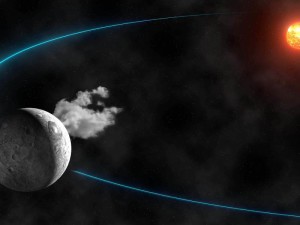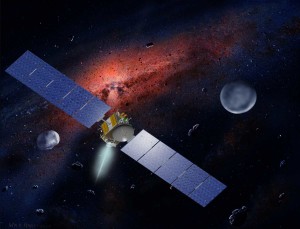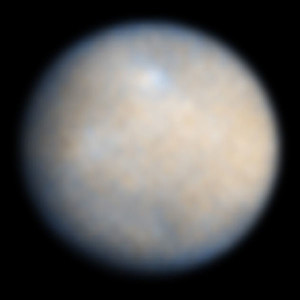
Artist’s rendition of the water vapor spewing from dwarf planet Ceres, which is shown in its orbit around the sun. (IMCCE-Observatoire de Paris/CNRS/Y.Gominet)
Scientists have found signs of water vapor on the dwarf planet known as Ceres.
“This is the first time water vapor has been unequivocally detected on Ceres or any other object in the asteroid belt and provides proof that Ceres has an icy surface and an atmosphere,” said Michael Küppers of the European Space Agency.
The scientists, writing in the journal Nature, believe the water vapor is produced on Ceres when its orbit brings it close enough to the sun to melt parts of its icy surface.
The water vapor, heated by the warmth of the sun, then blasts above the Dwarf planet in plumes at a rate of about 6 kilograms per second, according to the research team. The water vapor disappears whenever Ceres’ orbit takes it away from the sun.
Ceres is the largest and roundest object to inhabit the asteroid belt between the orbits of Mars and Jupiter.
Ceres is about 950 kilometers in diameter, has a rocky interior and is coated with a thick layer of ice. Scientists believe the dwarf planet has so much ice that if it were all melted, it would produce more fresh water than is available on Earth.
Up until 2006, Ceres was classified as a large asteroid, but then the International Astronomical Union (IAU), which is responsible for naming planetary objects, reclassified it as a dwarf planet because of its large size.
Along with Ceres, the IAU currently lists four other dwarf planets in our solar system. They are Pluto (formerly a full-fledged planet), Eris, Makemake and Haumea, all of which orbit the sun beyond Neptune. Of the five, Ceres is the only dwarf planet known to exist in the asteroid belt.
While it’s been previously thought that ice existed on Ceres, it wasn’t until scientists using tools such as the Herschel space telescope‘s Heterodyne Instrument for the Far-Infrared (HIFI) were able to spot a clear spectral signature of water vapor.

Artist concept of the Dawn spacecraft shown with asteroids Ceres (right) and Vesta (left). (William K. Hartmann/UCLA)
Comets, the icy relatives of asteroids, have been known to blast jets and plumes of gas and vapor, but the scientists were surprised to observe similar behavior on an object that resides in the asteroid belt.
Scientists will get a closer look at Ceres when NASA’s Dawn mission arrives for a scheduled visit during the spring of 2015. Dawn is on its way to Ceres after spending more than a year orbiting the large asteroid Vesta.
“We’ve got a spacecraft on the way to Ceres, so we don’t have to wait long before getting more context on this intriguing result, right from the source itself,” said Carol Raymond, NASA’s deputy principal investigator for Dawn. “Dawn will map the geology and chemistry of the surface in high-resolution, revealing the processes that drive the outgassing activity.”






















Years ago I deduced analytically, by improving on German Astronomer Bode’s rule for semi-major axis (roughly planetary distances from the sun), that the orbit of the Ceres asteroids was one of the eight legitimate ones, in a the list of eight orbits which surprisingly does not include orbits of Planets Earth and Neptune. This, I deduced, is indicative that Planets Earth and Neptune are collision-ejection objects existing in assumed unnatural orbits, their original orbits presently occupied by Mars and Uranus. My calculations and write up on this issue is detailed and contained in one of my books. This raises troubling questions about the nature of the creatures on earth, and perhaps Neptune, considering that these two planets have weird origins, and should be classified as extraneous, as should the creatures that have sprouted on it (or perhaps them). To be continued
are you saying Earth and Neptune were ejected from another star system? I”m not sure I buy this. Do you have a paper showing your evidence and analysis?
Im not sure i buy this either. However that could just be because im in highschool. Also if you have findings you should publish them to further the scientific community.
Thanks for your interest in this subject matter the conclusions of which are rather far reaching and point to rather circumstances in the origin and existence of living creatures First it could be shown, as I have done in my writings, that the naturally occurring planets formed at the inception of the Solar System are: Mercury, Venus, Mars, Ceres (Now broken up as the asteroid belt), Jupiter, Saturn, Uranus, and Pluto. Earth and Neptune were not in the picture when the Solar System was formed from proto-planets. A mathematical formula has been determined that precisely defines the orbits of the eight listed naturally occurring planets. Those of Earth and Neptune are not accommodated. To be continued
Back of the envelope says at this rate Ceres has outgassed the Earth Sea Level equivalent of a ball of water 40 kilometers in diameter. Ceres itself is about 975 kilometers and gravity is 5%. The question is, did some water rain back?
That would be a hydrological cycle. In an atmosphere, of sorts. And a lot of fun to find, if we do. More fun to catch, if we can. What might the salts accompanying these molecules imply about happenings below?